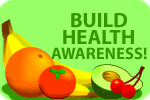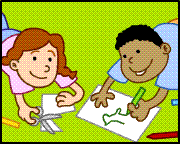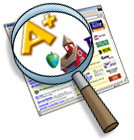| Volume 6, Issue 21
December 22, 2008
Theme: Go Away, Germs!
A WORD ABOUT THIS ISSUE'S THEME
As you talk with your students about staying healthy, remind them that some germs can make us sick. Explain that those germs can easily be passed from one person to another. Then use our poem to help reinforce the concept.
UGH Germs!
 Yucky germs!
Keep them away,
When you work
And when you play.
Cover up
That nasty sneeze
Use a tissue
Won't you please?
Wash your hands,
Count to 15…
Then you'll know
They're really clean.
All of us
Need to learn
The best ways
To fight off germs.
Susan LaBella
Editor, Early Childhood Education Newsletter
ACTIVITY IDEAS
GERMS GET AROUND
 Sprinkle a large amount of baby powder into one student's hands and have him/her pretend to sneeze into those hands. Explain to the class that the powder is the "germs" that have come out with the sneeze. Let the person who "sneezed" pass out one sheet of black paper to each student. (There should be traces of powder from the student's hands on the sheets of black paper.) Point out that this is how germs from a sneeze spread to hands and then to other objects: paper, door knobs, and so on. Go on to explain that if a person sneezes into his/her elbow, experts say that many fewer germs are spread. Demonstrate sneezing into your elbow and help children practice this technique. Sprinkle a large amount of baby powder into one student's hands and have him/her pretend to sneeze into those hands. Explain to the class that the powder is the "germs" that have come out with the sneeze. Let the person who "sneezed" pass out one sheet of black paper to each student. (There should be traces of powder from the student's hands on the sheets of black paper.) Point out that this is how germs from a sneeze spread to hands and then to other objects: paper, door knobs, and so on. Go on to explain that if a person sneezes into his/her elbow, experts say that many fewer germs are spread. Demonstrate sneezing into your elbow and help children practice this technique.
WATCH THAT SNEEZE!
Discuss the importance of covering your mouth when you sneeze. Explain that this stops germs from your mouth and nose from spreading. Now, give each child a paper plate. Let children decorate their plates to look like their own faces. Next give each child a tissue and let him/her glue it over the mouth of his/her face. Invite children to trace and cut out one of their hands. Staple the hand on top of the tissue. Children can hold up their paper-plate faces and repeat:
Uh Oh, I think
I'm gonna sneeze,
But … I have a tissue,
See??
WHY USE SOAP?
Talk with students about how germs are spread -- sneezing, touching doorknobs that someone with a cold has touched, and so on. Then try this simple experiment to underscore the importance fighting germs by washing hands with soap and warm water for 15 seconds. Arrange your students into pairs. Let one student in each pair cover his/her hands with washable paint. Allow the paint to dry. Have that student wash hands with water only for 15 seconds. That student's partner can then blot dry (not rub) the washer's hands. Let each pair of students examine the washer's hands. Are they completely clean? Now let the other student in each pair cover his/her hands with paint, allow it to dry, wash his/her hands for 15 seconds using water and soap, rinse, and dry well. Invite each pair of students to compare the cleanliness of their hands. Finally, reinforce with students the most appropriate times for hand washing -- after using the bathroom, before eating, after you sneeze, and so on.
GERMS EXPERIMENT
Arrange students into small groups (three or four students). Provide each group with four plastic bags. Each should have a label attached that identifies the bag as Bag 1, Bag 2, Bag 3, or Bag 4. Cover part of each group's work area with waxed paper. Place four potato slices on the waxed paper. (NOTE: Do not touch the inside, exposed surface of the potato. Handle the potato by the outer, skin-covered surface only. You might use toothpicks to pass out potato slices in order to avoid contact with the potatoes.) Tell students not to touch the potato yet. Ask each group to do the following:
- Potato slice #1: Ask students in each group to pass around the first potato slice; each student should have an opportunity to thoroughly handle the slice. Then have a student put the slice in Bag 1.
- Potato slice #2: Have students rub the second potato slice on a selected surface in the classroom (for example, the floor, a countertop, the classroom sink). Have them make note of where they rubbed it. Then ask a student to put that slice in Bag 2.
- Potato slice #3: Show students how to use a toothpick to handle the next potato slice. Tell students not to touch the potato or let it touch any surface. Have each student take a turn holding the toothpicked potato and blowing on it for about ten seconds. Ask a student to put that potato slice into Bag 3.
- Potato slice #4: Finally, have a student use a (clean) plastic fork to place the fourth slice in Bag 4. That [the "control" slice in the experiment] has not been touched, rubbed on any surface, or blown upon.
You might create a chart to identify what you have done to the potato in each bag.
Bag 1: Handled by group members
Bag 2: Rubbed on surface of _____
Bag 3: Blown on by group members
Bag 4: Control
Ask students to predict which potato slice contains the most germs and the least germs. Then have each group gather its four bags and place them in a dark closet. Leave the potato slices in the closet for a week. At the end of the week, have students refer back to the chart that identifies what they did to each potato. Ask students to answer the following questions: Which potato slice had the most germs? Which had the least? Why might that be? Did you predict correctly? Follow up with this question: What does this experiment teach you about the importance of washing your hands regularly?
FRUITS AND VEGETABLES
Remind children that eating healthful foods is another way to fight off illness and stay well. Read aloud to children Eating the Alphabet: Fruits and Vegetables from A to Z by Lois Ehlert. Allow children to say the name of each pictured fruit or vegetable aloud as you read. You might like to have on hand pieces of some of the fruits or vegetables for children to see and taste. (Be sure children wash hands before eating.) When you have finished reading, give each child an 8-1/2 by 11'' sheet of drawing paper. Invite children to draw and color one of the fruits or vegetables they would like best to eat. Laminate each child's paper and have children take them home to use as placemats.
ON THE WEB
Check out the following Web sites for additional background and activities.
 Stopping Germs at Home, Work, and School
Get helpful background information on stopping the spread of germs here.
http://www.cdc.gov/germstopper/home_work_school.htm
Squeaky Clean Song
Teach this song to your children as a fun way to remember the importance of hand washing.
http://www.wisdairy.com/SchoolResources/SchoolFoodservice/LunchLadyLesso...
Focus on Food
Do your kids know these fruits and vegetables? Make a game of guessing the names.
http://kidshealth.org/kid/closet/whatisit/food_game.html
School-Wide Hand Washing Campaigns Cut Germs, Absenteeism
Teachers, here is everything you need to know about the importance of hand washing in your fight against germs PLUS some great links and lesson plans to aid you in the battle!
http://www.educationworld.com/a_admin/admin/admin431.shtml
|